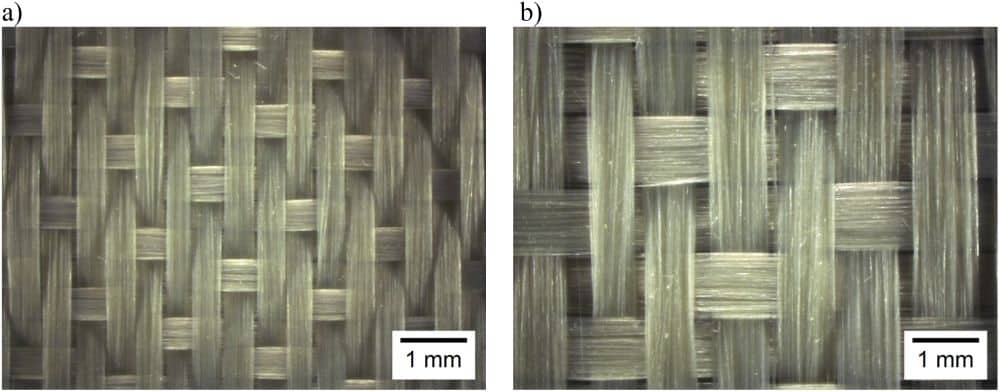
[Image above] Investigated Nextel 610 fiber fabrics: a) DF-11-1500-8HS and b) DF-13-4500-5HS. Credit: Almeida et al., Open Ceramics (CC BY-NC-ND 4.0)
Translating laboratory innovations into commercialized products is difficult, which is why the U.S. Congress made it a focus for policy in recent years. (For example, see this overview of the new National Science Foundation Directorate for Technology, Innovation, and Partnerships.)
Balancing cost and quality is one challenge researchers looking to commercialize their innovations must face. Even after commercialization, consistently maintaining high quality is a never-ending process of continuous analysis and improvement.
For example, all-oxide ceramic matrix composites (CMCs) are gaining increasing attention as a mainstream material option for high-temperature components in the aerospace and advanced energy sectors. But as the material moves from lab to production, cost reductions are required to ensure it is market-competitive with titanium and other high-temperature alloys.
Currently, Nextel 610 fibers from 3M Co. are recognized as having the highest tensile strength among commercially available oxide fibers. These fibers are fabricated using a sol-gel-based spinning process.
It is easier to control fiber morphology and microstructure when the extruded bundles have a relatively low filament count. As such, the highest filament count conventionally is fiber bundles with 1,500 denier. (Denier represents the mass, in grams, of 9,000 meters of fiber.)
A new offering by 3M demonstrates that the price of these fibers can be drastically reduced by increasing the filament count. The company recently started offering Nextel 610 fiber bundles with 4,500 denier, which are relatively priced about 36% cheaper than bundles with 1,500 denier.
Additionally, by using fiber bundles weaved in a 5 harness-satin pattern instead of the traditional 8 harness-satin pattern, the resulting Nextel 610 DF-13-4500-5HS fabric with 4,500 denier costs 60% less than the standard Nextel 610 DF-11-1500-8HS with 1,500 denier.
Some preliminary tests on these new fiber bundles, however, showed there are noticeable differences in the fiber morphology and bundle strength. So, more tests are needed to determine to what extent this cost reduction impairs the fibers’ mechanical properties “considering that [the fibers] are the main load-bearing component of a composite,” researchers write in an open-access paper.
The researchers come from the University of Bremen and the company Walter E.C. Pritzkow Spezialkeramik in Germany. In the recent paper, they compared the mechanical performance of all-oxide CMCs that use the Nextel fiber fabric DF-13-4500-5HS as reinforcement to ones that use the standard Nextel fiber fabric DF-11-1500-8HS.
In general, the CMCs featuring the new DF-13-4500-5HS fabric showed high strength under different types of mechanical loading, but the results were lower than for the standard CMC with DF-11-1500-8HS fabric. Specifically, when mechanical load was applied in the direction of the reinforcing fibers, the strength of the higher-denier fabric was about 15% lower. For off-axis properties, the strength of the higher-denier fabric was about 10% lower.
On the other hand, the higher-denier fabric can reduce the cost of raw materials by up to 60%. Additionally, the increased thickness of the higher-denier fabric means fewer layers are needed to obtain the desired component thickness. Fewer layers can lead to a labor time reduction of about 33% during critical processing steps, such as fiber infiltration, stacking, and shaping of all-oxide CMCs.
“In summary, there is a trade-off between mechanical properties and fiber cost. Nevertheless, the loss in mechanical performance can be compensated by the gain in cost efficiency depending on the application,” the researchers write. “This is a very important aspect since cost reduction can broaden the possible fields of application of [all-oxide] CMCs.”
The open-access paper, published in Open Ceramics, is “The use of bundles with higher filament count for cost reduction of high-strength oxide ceramic composites” (DOI: 10.1016/j.oceram.2023.100389).
